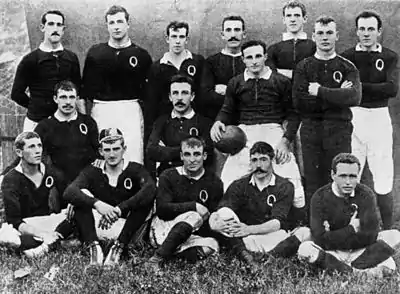Ernest Currie
Ernest William Currie (9 April 1873 – 23 October 1932) was a New Zealand-born rugby union international for Australia and a first-class cricketer.
| Birth name | Ernest William Currie[1] | ||||||||||||||||
|---|---|---|---|---|---|---|---|---|---|---|---|---|---|---|---|---|---|
| Date of birth | 9 April 1873[1] | ||||||||||||||||
| Place of birth | Dunedin[1] | ||||||||||||||||
| Date of death | 23 October 1932 (aged 59) | ||||||||||||||||
| Place of death | Randwick, New South Wales | ||||||||||||||||
| Rugby union career | |||||||||||||||||
| |||||||||||||||||
Cricket career
Currie, who was born in Dunedin, represented Otago in six first-class cricket matches during the 1894/95 and 1893/94 New Zealand cricket seasons, as a wicket-keeper.[2] He was regarded as one of New Zealand's best wicket-keepers of his time, "a lightning hand behind the sticks".[3]
After moving to Australia, he appeared in one further first-class match for Queensland, against New South Wales at the Sydney Cricket Ground in 1899.
Rugby union career
Currie, a scrum-half, claimed one international rugby cap for Australia. He played against Great Britain, at Brisbane, on 22 July 1899, the second ever Test match played by an Australian national side. His performance in that match was noted as "excellent" by the press.[6]
Personal life
He and his wife Annie had a son and two daughters.[7]
References
- "Scrum.com player profile of Ernest Currie". Scrum.com. Retrieved 12 July 2010.
- "First-Class Matches played by Ernest Currie". CricketArchive.
- "The Doyen of N.Z. Wicketkeepers". Dominion: 12. 11 October 1913. Retrieved 14 July 2018.
- "The BattleStained Queensland Team AS Photographed Immediately After The Match" (Photograph with caption.). The Queenslander. Brisbane, Australia. 8 July 1899. p. 73 S. Retrieved 17 September 2010.
- "International Football". The Queenslander. Brisbane, Australia. 8 July 1899. p. 73 S. Retrieved 17 September 2010.
- "INTERNATIONAL FOOTBALL". Queanbeyan Age. 26 July 1899. p. 2. Retrieved 8 August 2010.
- "Deaths". The Sydney Morning Herald: 8. 24 October 1932. Retrieved 14 July 2018.
